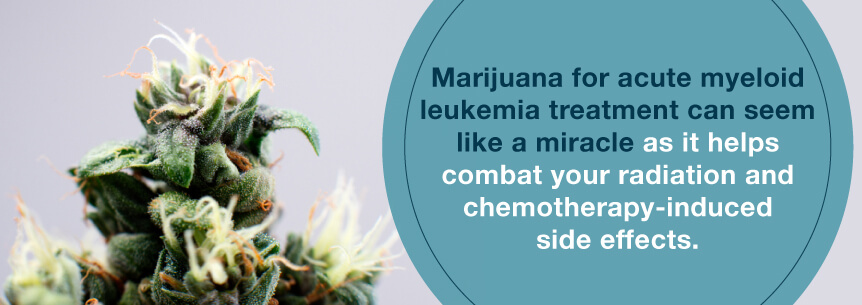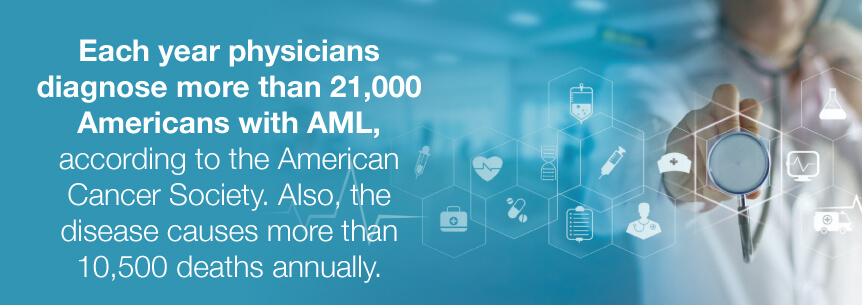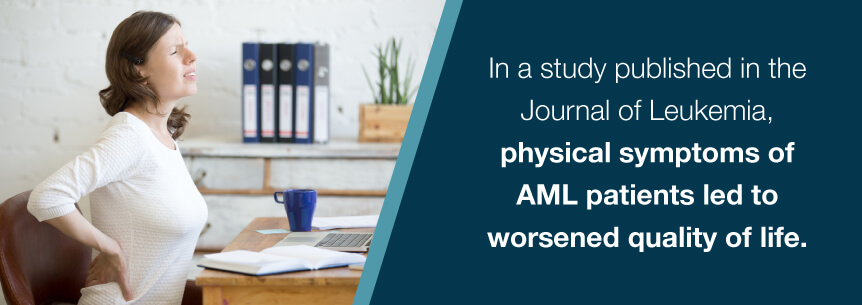Using medical marijuana during cancer treatment provides many benefits well known to patients, researchers and medical professionals. To deny cannabis’s power to alleviate nausea, pain and depression while you’re battling cancer not only contradicts science, but it only adds more stigma as well. Sure, the herb is therapeutic for symptoms of cancer treatments, but below we learn the benefits of medical marijuana for leukemia as well.
Marijuana and acute myeloid leukemia treatment can help decrease your pain and other debilitating chemotherapy side effects, such as the following:
As mentioned earlier, medical pot causes leukemia cells to die. It also helps prevent medical complications associated with bone marrow or stem cell transplants for AML. Research shows that medical marijuana for acute myeloid leukemia patients who receive CBD and then undergo a transplant have a substantially lower risk of getting GVHD (graft-versus-host disease). This is a transplant complication where the transplanted cells begin attacking the body.

When you’re fighting AML, marijuana for acute myeloid leukemia treatment can seem like a miracle as it helps combat radiation and chemotherapy-induced side effects. Here are some cannabis strains for acute myeloid leukemia symptom management.
One of the best types of medical cannabis for acute myeloid leukemia is cannabis oil.
For instance, one patient, Elias Cooper began to take cannabis oil a couple of years after he received his diagnosis. He took the oil consistently for three weeks and then went for a doctor checkup. The doctor found he had dramatically improved, which suggests cannabis oil was effective.
Donovan Vizina, another patient, received an acute myeloid leukemia diagnosis in 2013. He went through chemotherapy, but his treatment caused him more harm than it helped him. In 2015, he began using cannabis oil, and within six days, he was cured.
Other popular and effective cannabis administration methods for acute myeloid leukemia include:
Conduct the First Marijuana and Acute Myeloid Leukemia Step
If you’re not finding success with other standard treatments or if these treatments are causing you debilitating side effects, you may benefit from medical marijuana for acute myeloid leukemia. Your first step is to search for a medical marijuana doctor for a recommendation for your medical marijuana card. After you receive your medical cannabis treatment card, locate a cannabis dispensary for medical cannabis and CBD treatments.
Find A Doctor Find A Dispensary
Acute myeloid leukemia (AML) starts in your cells normally transforming into white blood cells. It’s a form of blood cancer. In some instances, AML may begin in your other blood-forming cells.
Each year, physicians diagnose more than 21,000 Americans with AML, according to the American Cancer Society. Also, the disease causes more than 11,540 deaths annually.
AML begins in your bone marrow, which is the soft inner parts of your bones. Your bone marrow cells are supposed to mature. However, when it comes to AML or other types of acute leukemia, your bone marrow cells are immature, and they continue to build up.

Doctors refer to AML by various names, such as:
Without timely treatment, this disease can become life-threatening. It’s progressive, meaning it can quickly spread throughout the body to the following areas:
People differ in the way AML affects them, and it depends on various factors, including the AML subtype, your age, whether it’s a reoccurring cancer and if you’ve received chemotherapy treatment in the past.
Physicians use blood and bone marrow tests, along with your medical history and symptoms description to diagnose acute myeloid leukemia. To determine if the cancer has spread, doctors perform a lumbar puncture, a CT scan or both.
A key factor separating AML from other leukemia types is its eight subtypes. What cell your leukemia develops from will decide your subtype. F-A-B acute myeloid leukemia subtypes are dependent on disease pathology, such as cell maturity and types from tissue samples derived from patients. F-A-B AML subtypes range from M0 through M7 and involve varying stages of malignant cellular immunity. F-A-B subtypes are based on fewer symptoms and disease features than WHO standards.
Talk to your doctor about your acute myeloid leukemia subtype.
In 1869, Neumann first coined the term “myeloid” when he discovered white blood cells or leukocytes are produced in the bone marrow, not the spleen as originally believed. The term “acute leukemia” was first used by Wilhelm Ebstein in 1889 to show the difference between fatally aggressive, rapidly progressive, and slow-growing chronic leukemias.
AML was the first fully sequenced cancer genome in 2008. Researchers extracted DNA from leukemic cells and compared them to healthy, normal, and unaffected tissues. Several genes in the leukemic cells are acquired mutations that weren’t originally associated with leukemia previously.

General signs of AML during the early stages of disease activity are similar to symptoms of the flu and other common medical conditions. Symptoms also vary depending on the type of blood cells affected.
AML symptoms include:
If you develop any worrisome symptoms or something that seems unusual, contact your doctor.
When you have AML, there are a variety of complications that could occur. These complications are common with the disease and treatment side effects, and may include the following:
With AML, bruising and bleeding occurs easily because of low blood platelets. Platelets are clot-forming cells. Excessive bleeding or hemorrhaging can also occur inside the body, which increases vulnerability to advanced disease activity. This is the second leading cause of death in patients with this disease.
Excessive bleeding may occur:
These hemorrhages are all considered medical emergencies, pain may also occur and some people with AML are asymptomatic. Anyone experiencing these symptoms should seek emergency medical care immediately.
A common AML complication is being immunocompromised or having a weak immune system. Even if treatment helps restore your blood to normal working order, various AML treatments can still weaken your immune system temporarily.
Because of this, susceptibility to more severe infections is common. The leading cause of death in AML patients is infection-related complications. Early treatment can help prevent this and ensure favorable outcomes.
Many acute myeloid leukemia treatments can cause infertility. Though usually temporary, infertility can become permanent. AML patients risk permanent infertility after undergoing high doses of radiotherapy and chemotherapy in preparation for stem cell or bone marrow transplants.
The doctors treating you can provide you with an estimate of your chances of infertility due to your specific situation. Before beginning treatment, you may take precautions against infertility. For instance, women may have fertilized embryos or eggs stored, and the doctor can place them back in their womb after being treated. Men may store samples of their sperm.
Since acute myeloid leukemia is an aggressive disease and develops quickly, though, you might not have the time to do this before you need to start treatment. This is another reason why early diagnosis is necessary.
Cancer has a profound impact on patients and their loved ones. It can lead to:
In a study published in the Journal of Leukemia, physical symptoms of AML patients led to worsened quality of life. Fatigue is a common symptom in patients with AML, despite controlling physiological effects, such as anemia. Older chemo patients, 60 or older, had moderate to strong fatigue scores correlating with physical, social, emotional and cognitive health and function. Additionally, there were moderate and strong associations between depression and fatigue as well throughout the study.

2022 estimates for leukemia by the American Cancer Society are:
A few treatments can help with AML. These are:
There are a couple of phases of your treatment as well:
Remission induction therapy (RIT) is administered during the first three to four weeks of treatment, usually right after diagnosis. RIT involves different chemo medications designed to destroy as many cancerous cells as possible to help restore normal blood counts and halt disease activity.
Once you receive treatment, your bone marrow will begin making healthy blood cells. To determine if you have any more leukemia cells in your blood, your doctor will take samples of your bone marrow. If they don’t spot any, they’ll consider you “in remission.” To stay in remission, post-remission therapy is necessary.
During this phase, any leftover cancer cells from chemo are wiped out using more treatments. Post-remission therapy is also beneficial to help prevent new cancer cell activity. There are a few options:
Once a month, you’ll receive two to four cycles of high-dose chemo. During this treatment, your doctor uses strong medications to kill the cancer cells in your body. You may receive these drugs intravenously via an IV, orally by mouth, or needle injection.
If your cancer has spread, chemo injections into the fluid around the spinal cord and brain are beneficial and standard. Doctors refer to this as intrathecal chemotherapy.
Side effects of chemo may include:
Radiation treatment destroys cancer cells using high-energy X-rays. Radiation is typically an option for AML that has spread to the spinal cord, brain, or bone. Some patients receive radiation before undergoing stem cell transplantation.
Side effects of radiation include:
Higher chemo doses destroy more cancerous cells. However, high doses of chemo can cause blood cell levels to drop to dangerously low levels and damage the bone marrow in some patients.
Stem cell transplants are often required to help regenerate new bone marrow tissue. Stem cell therapy involves using patient or donor stem cells to grow healthy, new blood cells.
Stem cell transplant side effects commonly include temporary hair loss, fatigue, nausea and vomiting — all related to radiation therapy or chemotherapy. Other side effects are common with stem cell transplant and high-dose chemotherapy. In most cases, side effects resolve after treatment is complete.